Kanom Jeeb Thai dumplings is a beloved street food and a delicacy found among cart vendors and in all types of restaurants in Thailand. They are loved by Thai people tourists alike, so you know you're in for a treat when you try them.
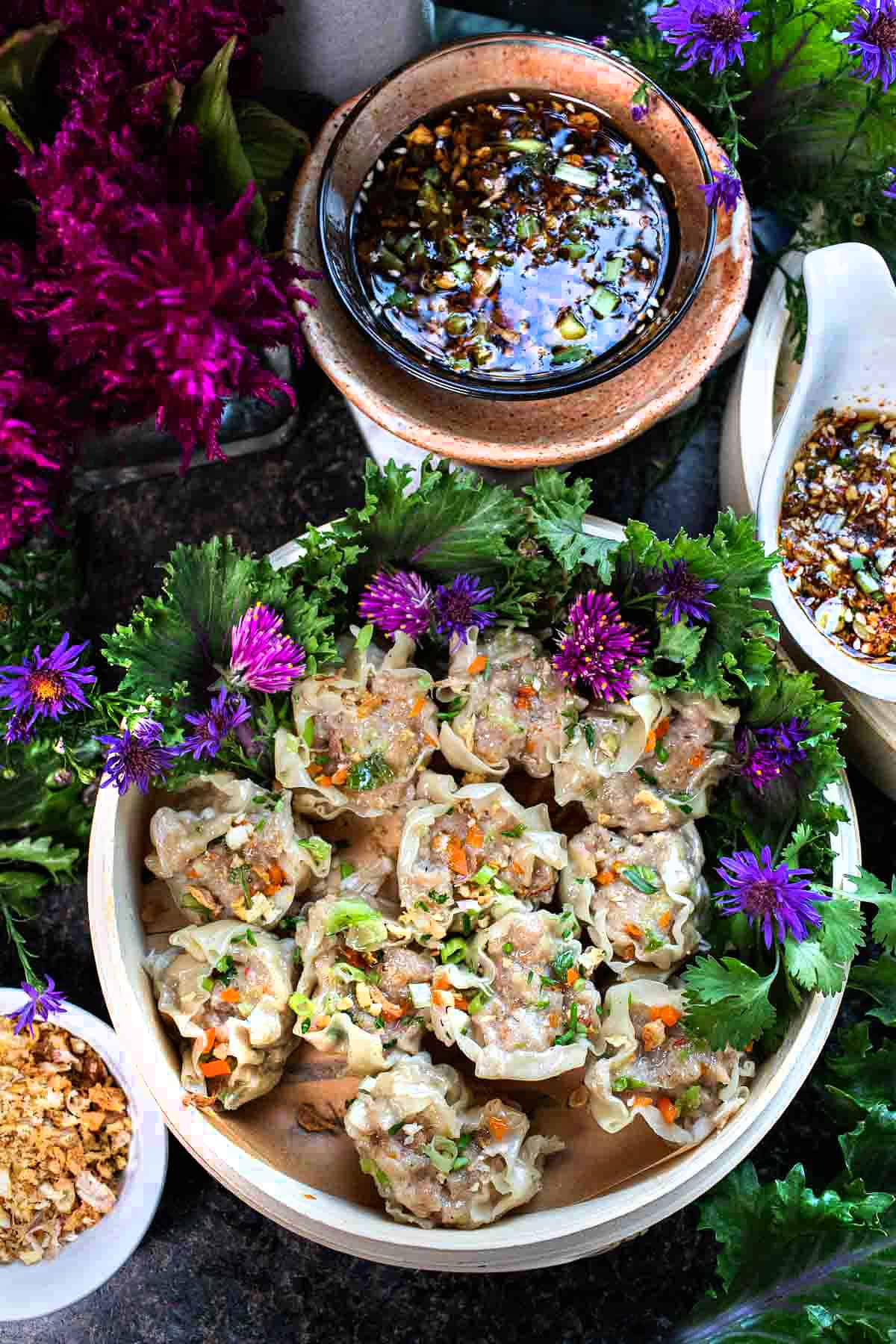
Try also these delicious Thai egg rolls, Thai fish cakes, Moo Yang (grilled pork neck), Thai beef jerky, Gai tod, Gai Yang, Thai grilled chicken, Khao Jee, Thai shrimp cakes, and Son-in-law eggs for more popular Thai appetizers.
For a comforting Thai soup with dumplings, make sure to try this recipe!
Jump to:
- Why You'll Love Kanom Jeeb
- What is Kanom Jeeb?
- Ingredients for Thai Dumplings Recipe
- Setting Up a Dumpling Wrapping Station
- How to Make Kanom Jeeb Thai Dumplings
- Garnishing Options
- Helpful Kitchen Notes and Tips
- Helpful Kitchen Tools for Making Thai Dumplings
- What to Serve with Kanom Jeeb Thai Dumplings
- Variations
- Substitutes
- Storage
- Top Tip for Making Kanom Jeeb
- Frequently Asked Questions
- More Thai Recipes You'll Love
- Kanom Jeeb Thai Pork Dumplings
- More Thai Recipes You'll Love
Why You'll Love Kanom Jeeb
- Delicious flavors: Kanom Jeeb Thai dumplings are bursting with mouthwatering flavors that will make your taste buds dance.
- Soft and chewy texture: These pork and shrimp dumplings have a perfect balance of softness and chewiness, giving you a delightful eating experience.
- Fresh and healthy ingredients: Kanom Jeeb is made with fresh and nutritious ingredients like shrimp, pork, and vegetables, ensuring a healthy and satisfying meal.
- Easy to eat: These bite-sized dumplings are easy to pick up and enjoy, making them a great option for a quick, hassle-free snack or meal.
- Versatile and customizable: You can enjoy Kanom Jeeb with different dipping sauces and toppings, allowing you to personalize your dumplings to your own taste preferences.
- Beautifully presented: Thai dumplings are often elegantly crafted, making them visually appealing and a treat for your eyes and taste buds.
What is Kanom Jeeb?
Kanom Jeeb, often referred to as "Shumai" or "Shu Mai" in other Asian cuisines, like dim sum, is a steamed Chinese dumpling. These bite-sized delights are a tasty Chinese dish consisting of a translucent, thin wrapper enveloping a savory mixture of ground pork, shrimp, and an array of seasonings.
You may know them as Dim Sum in the West and Chinese Dim Sum restaurants.
Ingredients for Thai Dumplings Recipe
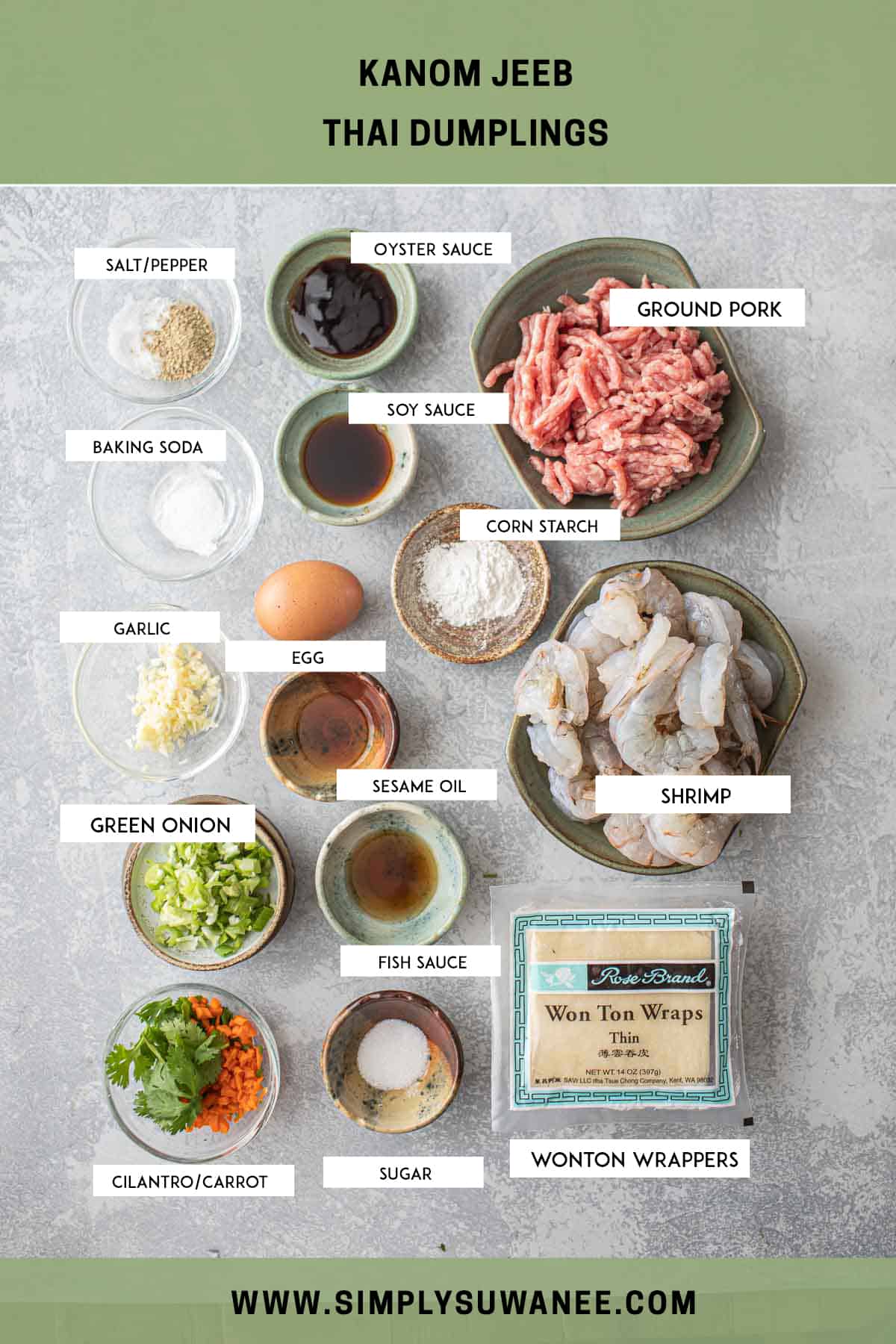
- Garlic. We'll be pounding the garlic, white pepper, and salt together to make a delicious paste that makes these dumplings distinctively Thai.
- Ground white pepper. Black pepper is okay as a substitute, but ground white pepper will add more flavor to your dumplings.
- Salt. You need a small amount to help loosen the garlic in a mortar and pestle.
- Raw shrimp. Tails, heads, and shells removed.
- Ground pork. Ground chicken or turkey will work, but it won't have the sweet pork meat flavors.
- Egg. Adds a tender, soft texture to the dumpling mixture.
- Mushroom soy sauce. Mushroom soy sauce is lighter and tastier than most regular soy sauce. It makes a difference in the flavors of these dumplings. They are sold in most Asian markets.
- Fish sauce. Squid brand. Find these at your local Asian markets.
- Oyster sauce. Thai brand is best, but use what you have.
- Sesame oil. Adds a toasty, nutty flavor to the dumplings. In Thai cuisine, sesame oils are used mostly in Chinese-influenced dishes like Kanom Jeeb.
- Sugar. White sugar is used for my recipe, but brown sugar is fine.
- Coriander stems. If you have the roots, use 3-4 roots. Coriander makes these dumplings with distinctively Thai flavors.
- Green onion. One of the main herbs used. Don't skip out on this one.
- Corn starch. Use to help thicken and bind all the ingredients together. Use tapioca flour or starch as substitutes.
- Baking soda. Baking soda helps make your dumplings light and fluffy, making that soft, chewy texture fun to eat!
- 25-30 Wonton wrappers. Rose brand thin wonton wrappers are my favorites to work with. Look for those at your local grocery stores.
Setting Up a Dumpling Wrapping Station
Setting up a wrapping station with needed items will help speed the wrapping process. So, use my photo guide to help with your setup. Having all the main ingredients ready and within reach is extra helpful.
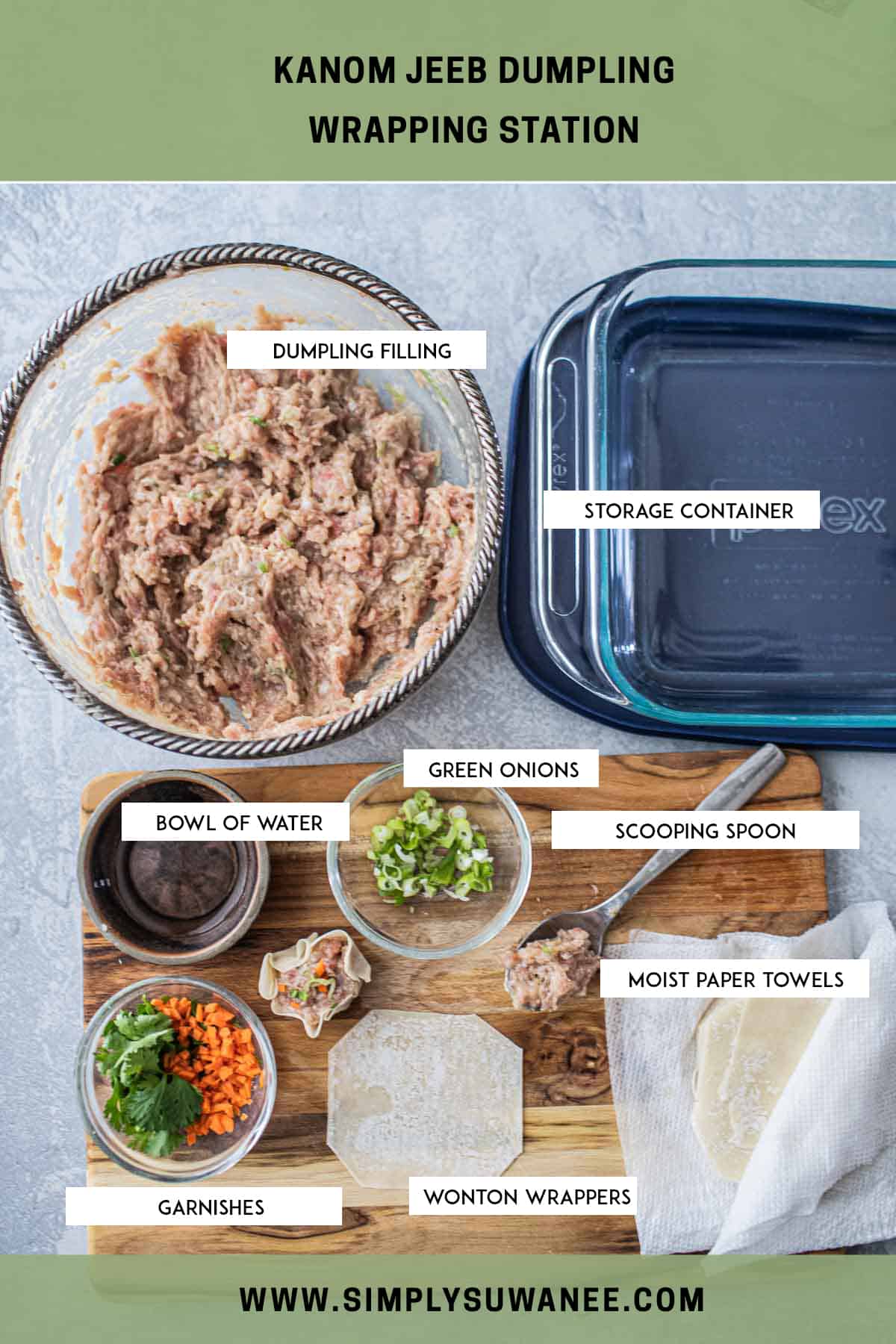
- A small bowl of water. Wetting the edges of your wrappers to help soften up the top edges and keep them from drying out while wrapping the rest of the Kanom Jeeb.
- Garnishing ingredients. I used finely chopped carrots, green onion, and cilantro stems. The cilantro stems add so much flavor, and it's distinctively Thai. Give it a try!
- A spoon. For scooping out the filling into your wrapper. And when the spoon gets sticky, quickly dip it in the small water bowl to help for a smooth scoop.
- A storage container for your finished Kanom Jeeb. I used a food glass container with a lid for easy storage and freezing if I couldn't use my wrapped dumplings.
- Damp paper towels. Lightly moist 2-3 sheets of paper towels and place around your wonton wrappers to keep them from drying out.
- More damp paper towels or clean, moist kitchen washcloths or towels. Your fingers will get sticky from working with the meat mixture and the flour wrappers. Having a hand wipe for a quick wipe is handy, so you don't have to get up to wash your hands every few wraps.
How to Make Kanom Jeeb Thai Dumplings
Step 1: Make Thai dumpling paste
Add garlic, ground white pepper, and salt and pound to a smooth paste in a small mortar and pestle. Set aside until ready.
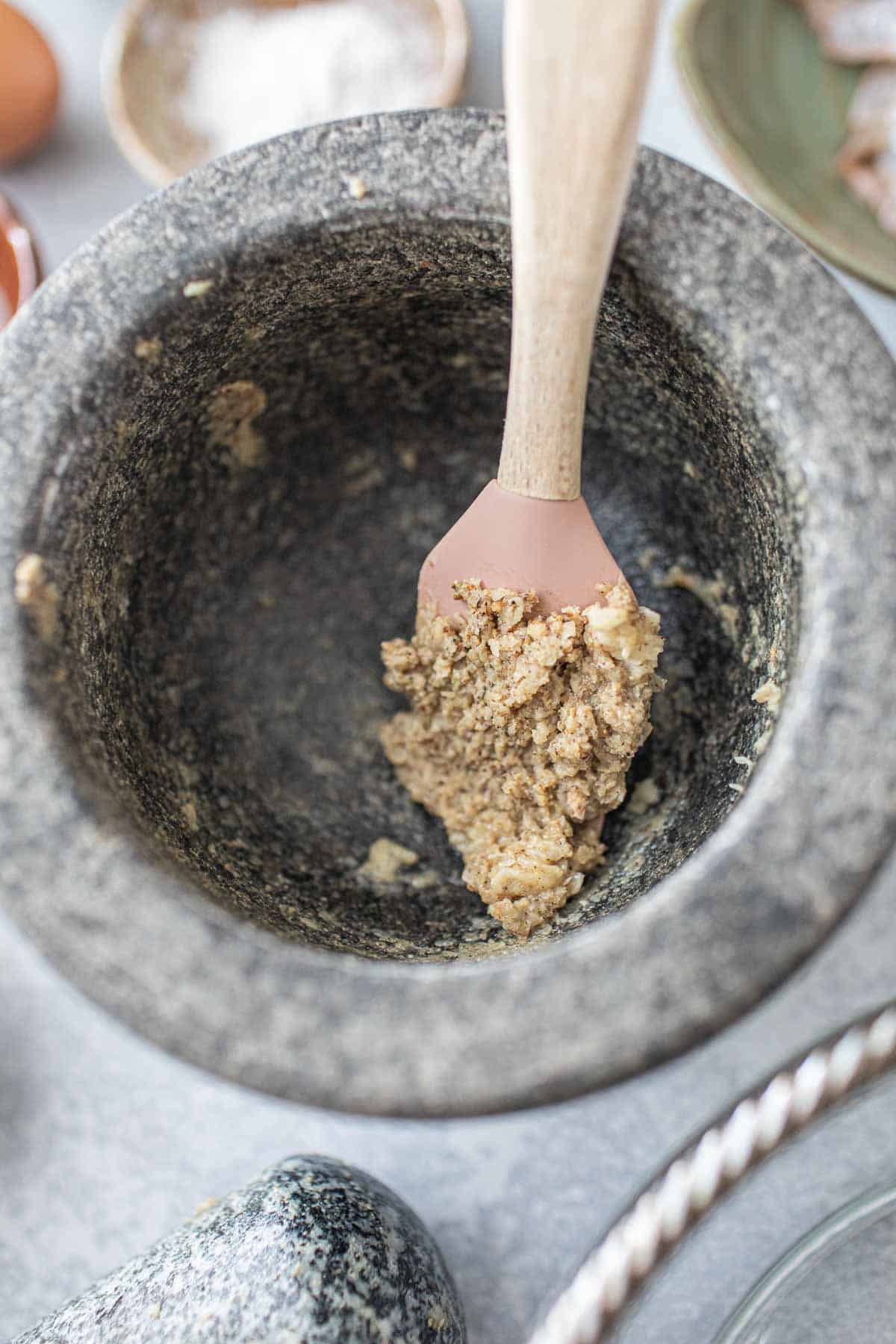
Step 2: Make a shrimp paste mixture. Blend the shrimp in a food processor until you have a thick, sticky mixture. Customize it here in your food processor by making the shrimp mixture smooth or leaving some small chunks.

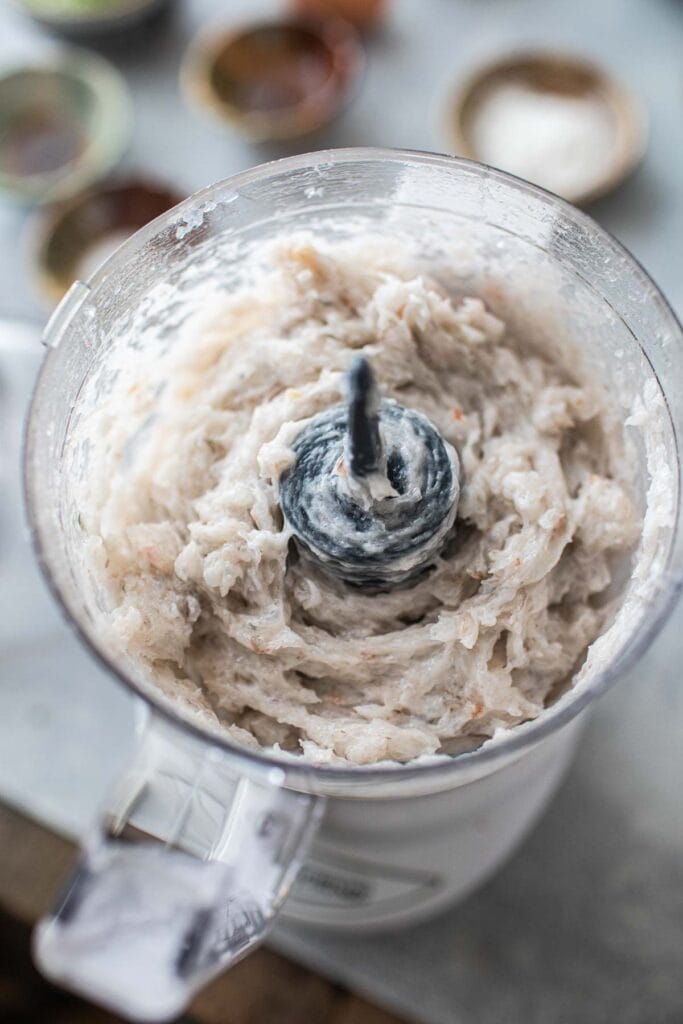
Step 3 Creating the Filling. In a medium bowl, combine shrimp mixture, ground pork, minced coriander stems (or root if available), chopped green onions, egg, corn starch, fish sauce, oyster sauce, light soy sauce, sesame oil, and sugar. This is the soul of your dumplings.
Leave a small amount of cilantro stems and green onions for the top of the dumplings.


Step 4. Test your dumplings. Grab a small amount of your uncooked mixture, microwave for 20-30 seconds, and test to see if you love the flavors. Add more fish sauce, soy sauce, sesame oil, or white pepper as needed. Test until you are content with the flavors.
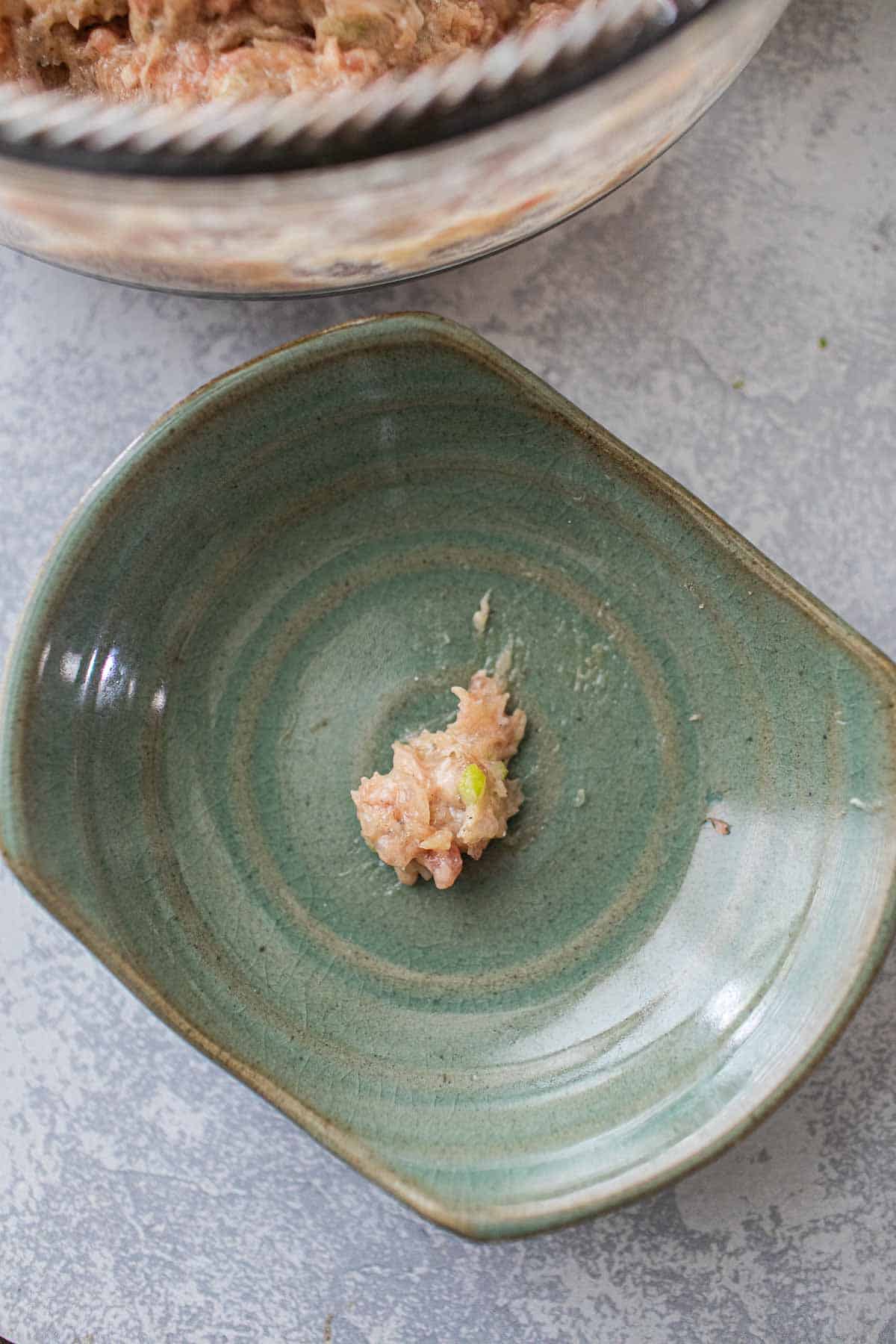
Step 5: Set up your wrapping station. See my setting up your shrimp and pork dumplings section above for a reference.
Step 6: Wrapping the Dumplings
Lay out your wonton wrappers. If using square wrappers, cut off all 4 corners so you don't have extra pieces of wonton wrappers sticking out.

Wet the edges of the wrapper on a flat surface. Make a circular shape with your fingers, like an O, then place the wrapper inside the hole, holding it loosely.
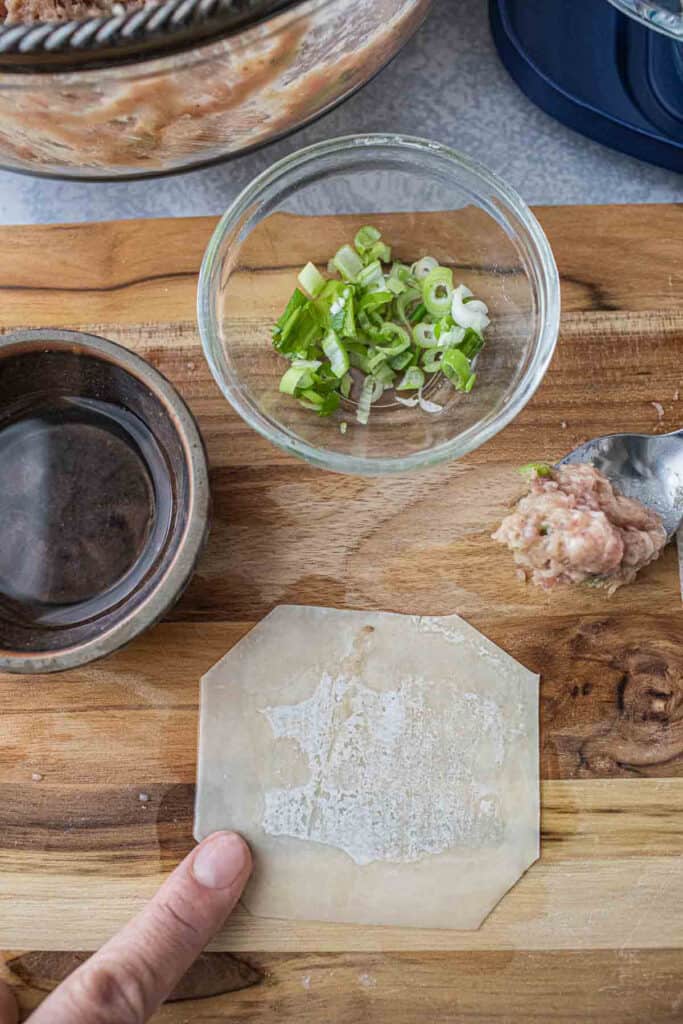

Using a spoon, place a small amount of the filling in the center of each wrapper. Lightly tighten your O with your fingers until the edges of the wrapper look like a pleated pattern.
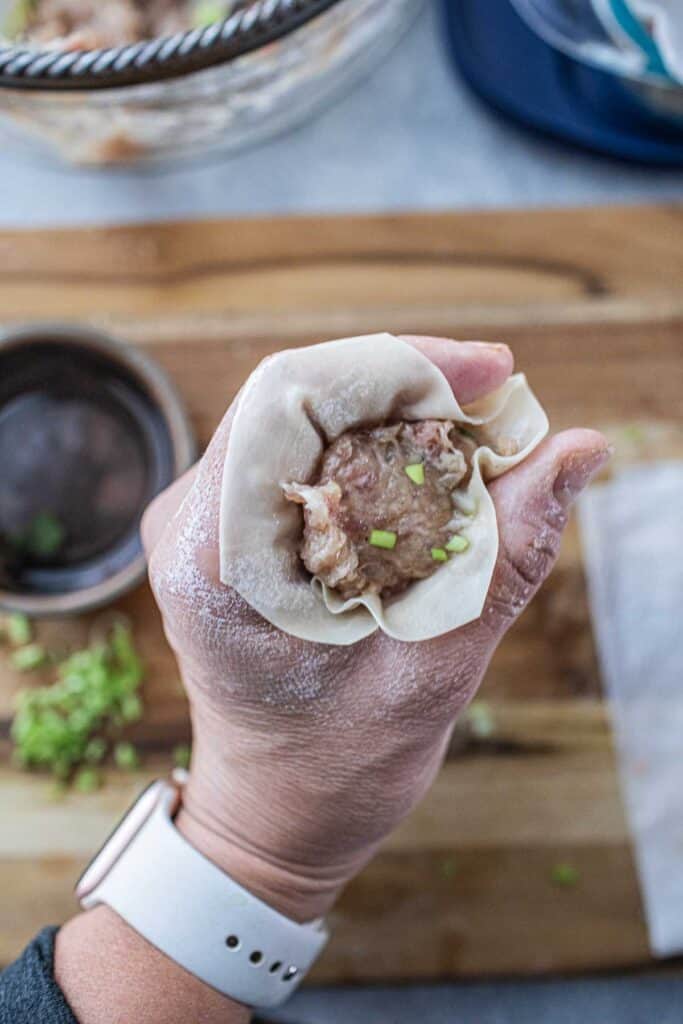

Add chopped carrot, green onion, and cilantro stems to the top of each dumpling. Place them in a storage container or a shallow pan. Lightly flatten out the bottom of the dumpling so it will sit straight when steamed.

Repeat until all the filling is used from your mixing bowl.
Step 6: Steaming the Dumplings
Arrange your dumplings in a bamboo steamer or basket lined with parchment paper to prevent sticking—steam over medium-high heat for 10-15 minutes until the dumplings are cooked.
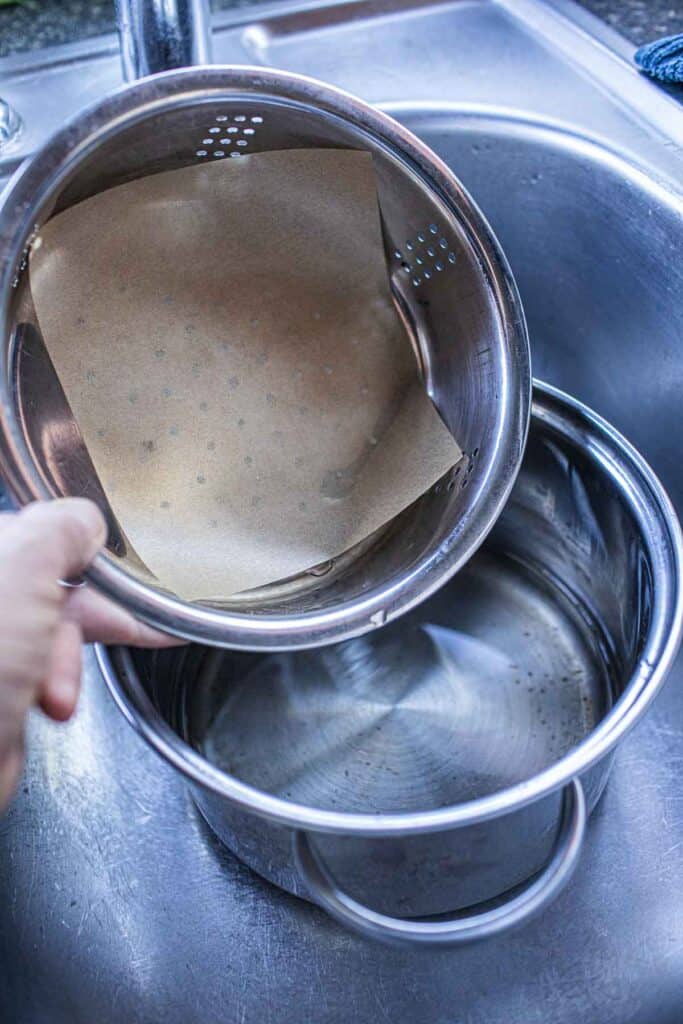
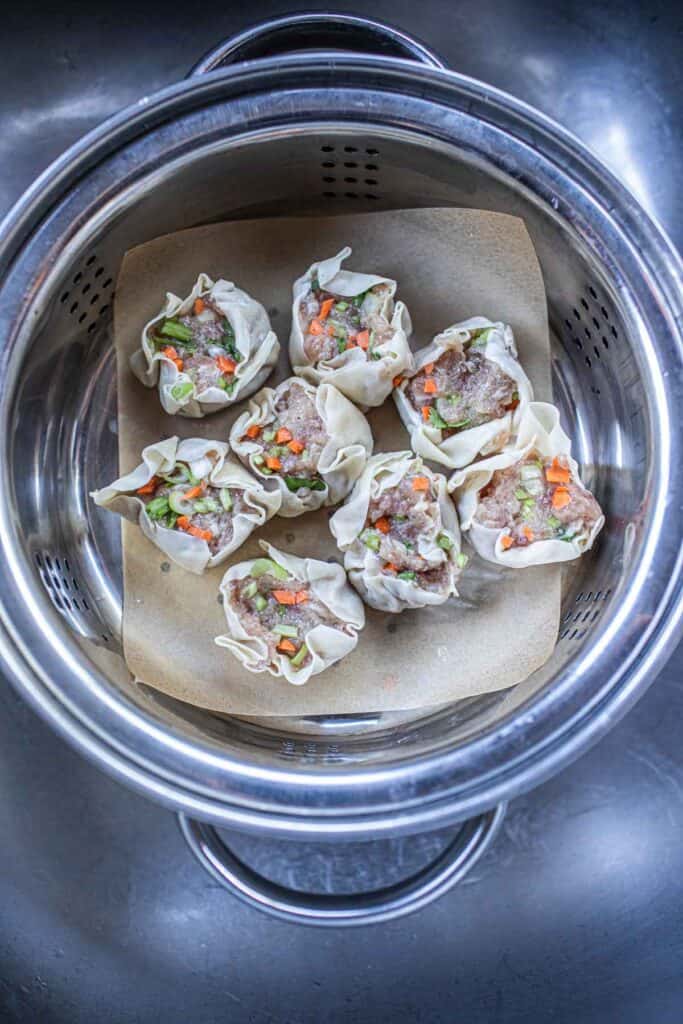
Step 7: Preparing the Dipping Sauce
While the dumplings steam, whisk together a dipping sauce of your choice, typically featuring soy sauce, rice wine vinegar, a pinch of sugar, and a dash of sesame oil. Adjust the proportions to suit your taste buds.
Step 8: Presentation and Garnishing
As your dumplings emerge from the steam, arrange them on a serving plate. Drizzle garlic oil over the top for an extra layer of flavor. Garnish with crispy fried garlic, cilantro, and finely chopped green onions to enhance visual appeal and taste.

Step 9: Serving and Savoring
Serve your Kanom Jeeb Thai Dumplings hot as a standalone appetizer or as part of a grand Thai banquet. The delectable aroma and flavors will transport you to the heart of Thai culinary culture.

Garnishing Options
- These steamed Thai dumplings are typically served with crispy garlic and garlic oil sprinkled over the top.
- Fresh cilantro leaves and red pepper flakes make for an eye-catching and tasty garnish.
- For an added crunch, sprinkle crushed peanuts over the dumplings.
Helpful Kitchen Notes and Tips
- Make sure that the wonton wrappers are covered with a damp cloth to prevent drying out while you work.
- A food processor can significantly speed up the preparation process, especially when mincing coriander root.
- When steaming, leave some space between dumplings to prevent sticking. They will expand to ⅓ of the uncooked size, so don't overcrowd your dumplings.
- Brush a light coat of oil on the bottom of the parchment paper to keep the dumplings from sticking together.
Helpful Kitchen Tools for Making Thai Dumplings
- Bamboo steamers: Perfect for steaming your dumplings to perfection.
- Stainless steel steamer
- A stainless steel steamer basket
- Parchment paper
- Food processor: Ideal for mincing coriander root and finely chopping shrimp.
What to Serve with Kanom Jeeb Thai Dumplings
These dumplings are a star on their own, but you can serve them with a side of salad, jasmine rice, or Thai noodle salad for a more substantial meal.
Variations
- Some Thai versions of Kanom Jeeb incorporate garlic oil or garlic-infused water in the filling for an extra aromatic touch.
- Experiment with different dipping sauces – sweet chili sauce or a zesty Sriracha sauce are excellent options.
Substitutes
- If you can't find coriander root, cilantro stems work as a substitute.
Storage
- Kanom Jeeb Thai Dumplings are best enjoyed fresh. However, you can store leftovers in an airtight container in the refrigerator for a day or two.
- Uncooked dumplings freeze well! Keep them in an airtight container in the freezer for up to 3 months. Thaw them out for 1 hour before steaming for eating.
Top Tip for Making Kanom Jeeb
- A sprinkle of tapioca starch on the bottom of the dumplings prevents them from sticking to the steamer.

Frequently Asked Questions
While they share some similarities, there are minor differences in ingredients and flavors between Thai Kanom Jeeb and Chinese Pork Siu Mai.
These steamed Thai dumplings represent the delicate and balanced flavors that are a hallmark of Thai cuisine, making them an integral part of the culinary landscape.
Absolutely. You can use store-bought wonton wrappers if you're short on time. However, homemade wrappers can take your Kanom Jeeb to the next level.
You can find these steamed delights in many Thai restaurants, often served as appetizers.
Yes! Ground chicken is a fantastic substitute for pork, creating a unique flavor profile.
Steam them with enough water to maintain steam but not so much it wets the dumplings excessively. The result should be a delicate, translucent wrapper.
More Thai Recipes You'll Love
- Pad Thai: The iconic Thai stir-fried noodle dish.
- Thai Green Curry: A fragrant and spicy Thai curry with your choice of protein.
- Tom Kha Gai: A creamy and aromatic Thai coconut soup with chicken.
- Gai Tod. Thai fried chicken wings
**Love a recipe you've tried? Please leave a 5-star rating in the recipe card below and a review in the comments section further down the page. Or follow me on Facebook, Pinterest, or Instagram!**
Print
Kanom Jeeb Thai Pork Dumplings
- Total Time: 45 minutes
- Yield: 8
- Diet: Low Calorie
Description
Kanom Jeeb Thai Dumplings is a beloved street food and a delicacy found in all types of restaurants in Thailand. They are loved by Thai people and tourists alike, so you know you're in for a treat when you try them.
Ingredients
- 4 large cloves of garlic
- ½ teaspoon ground white pepper
- 1 teaspoon salt
- ½ pound shrimp, tails, heads, and shells removed.
- 4 ounces ground pork
- 1 egg
- 2 tablespoons mushroom soy sauce
- 1 tablespoon fish sauce. Squid brand
- 1 tablespoon oyster sauce
- 1 teaspoon sesame oil
- 1 teaspoon sugar
- 1 ½ tablespoons cornstarch
- ¼ teaspoon baking soda
- 2 stalks green onion, finely chopped
- 25-30 wonton wrapper
- For toppings. Use finely minced green onion, carrot, and cilantro, finely minced.
For the dipping sauce
- 2 tablespoons mushroom soy sauce
- 2 teaspoon water
- 1 teaspoon sesame oil
- 1 teaspoon rice vinegar
- 1 ½ teaspoon sugar
Mix the ingredients in a small bowl until the sugar dissolves. Adjust as needed to your flavor profile.
Optional ingredients to add to sauce: Sesame seeds, finely chopped green onion, cilantro, and chili flakes.
Instructions
- Make Thai dumpling paste. Add garlic, ground white pepper, and salt and pound to a smooth paste in a small mortar and pestle. Set aside until ready.
- Make a shrimp paste mixture. Blend the shrimp in a food processor until you have a thick, sticky mixture. Customize it here in your food processor by making the shrimp mixture smooth or leaving some small chunks.
- Creating the Filling. In a medium bowl, combine shrimp mixture, ground pork, minced coriander stems (or root if available), chopped green onions, egg, corn starch, baking soda, fish sauce, oyster sauce, light soy sauce, sesame oil, and sugar. This is the soul of your dumplings. Leave a small amount of cilantro stems and green onions for the top of the dumplings.
- Test your dumplings. Grab a small amount of your uncooked mixture, microwave for 20-30 seconds, and test to see if you love the flavors. Add more fish sauce, soy sauce, sesame oil, or white pepper as needed. Test until you are content with the flavors.
- Set up your wrapping station. See my setting up your shrimp and pork dumplings section above for a reference.
- Wrapping the Dumplings. Lay out your wonton wrappers. If using square wrappers, cut off all 4 corners so you don't have extra pieces of wonton wrappers sticking out.
- Wet the edges of the wrapper on a flat surface. Make a circular shape with your fingers, like an O, then place the wrapper over the whole.
- Using a spoon, place a small amount of the filling in the center of each wrapper. Lightly tighten your O with your fingers until the edges of the wrapper look like a pleated pattern.
- Add chopped carrot, green onion, and cilantro stems to the top of each dumpling. Place them in a storage container or a shallow pan. Lightly flatten out the bottom of the dumpling so it will sit straight when steamed.
- Repeat until all the filling is used from your mixing bowl.
- Steaming the Dumplings. Arrange your dumplings in a bamboo steamer or basket lined with parchment paper to prevent sticking—steam over medium-high heat for 10-15 minutes until the dumplings are cooked.
- Preparing the Dipping Sauce. While the dumplings steam, whisk together a dipping sauce of your choice, typically featuring soy sauce, rice wine vinegar, a pinch of sugar, and a dash of sesame oil. Adjust the proportions to suit your taste buds.
- Presentation and Garnishing. As your dumplings emerge from the steam, arrange them on a serving plate. Drizzle garlic oil over the top for an extra layer of flavor. Garnish with crispy fried garlic, cilantro, and finely chopped green onions to enhance visual appeal and taste.
- Serving and Savoring. Serve your Kanom Jeeb Thai Dumplings hot as a standalone appetizer or as part of a grand Thai banquet. The delectable aroma and flavors will transport you to the heart of Thai culinary culture.
Notes
- Make sure that the wonton wrappers are covered with a damp cloth to prevent drying out while you work.
- A food processor can significantly speed up the preparation process, especially when mincing coriander root.
- When steaming, leave some space between dumplings to prevent sticking. They will expand to ⅓ of the uncooked size, so don't overcrowd your dumplings.
- Brush a light coat of oil on the bottom of the parchment paper to keep the dumplings from sticking together.
** Thank you so much for visiting my blog! This is truly a passion for me. If you have enjoyed these recipes and appreciate the hard work I put into them, I would love it if you would share them with your friends! Your recommendation is the highest review I could hope for, and I’d appreciate it! **
- Prep Time: 30
- Cook Time: 15
- Category: Appetizers
- Method: Steaming
- Cuisine: Thai
More Thai Recipes You'll Love
Looking for other recipes like this? Try these:

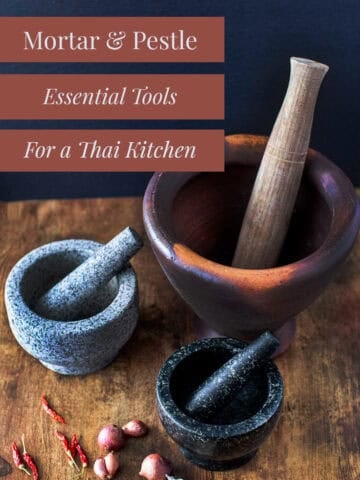



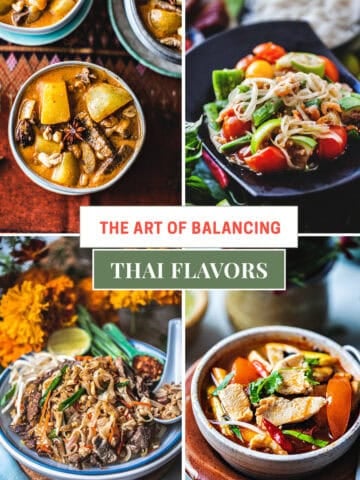


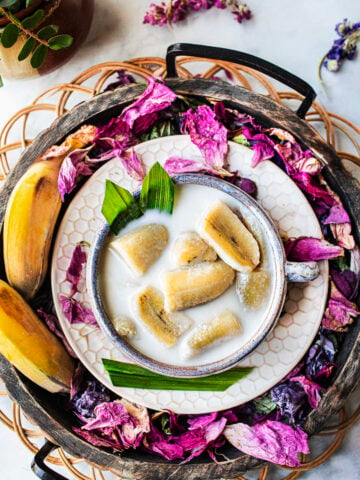
Marisa says
I am a big fans of Thai kanom jeeb and this recipe is amazing! It is hard to find authentic Kanom jeeb in the US and this recipe taste just like the ones in Thailand!